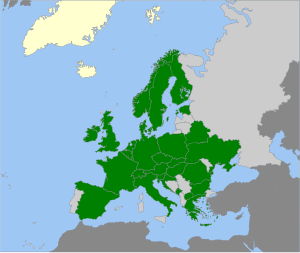Cherry red Spei-Täubling
| Cherry red Spei-Täubling | ||||||||||||
|---|---|---|---|---|---|---|---|---|---|---|---|---|

Cherry-red Spei-Täubling ( Russula emetica ) |
||||||||||||
| Systematics | ||||||||||||
|
||||||||||||
| Scientific name | ||||||||||||
| Russula emetica | ||||||||||||
| ( Schaeff .: Fr. ) Pers. |
The cherry-red Spei-deaf ( Russula emetica ) is a leaf fungus from the family of the deaf relatives (Russulaceae) and the type of the genus Russula . The medium-sized Täubling has a blood to vermilion hat, white lamellas, white spore powder and soft, very pungent-tasting and fruity-smelling meat. The spores are spherical to ellipsoid and densely fine-networked and prickly. The fruiting bodies appear solitary to gregarious from July to November, mostly in bog and moist coniferous forests. The common to fairly common deafbling is slightly poisonous.
features
Macroscopic features
The hat is initially arched, later spread out and quite a bit depressed towards the middle. It reaches a diameter of 3–10 centimeters, the 2/3–4/4 peelable cap skin is more or less strong cherry red and usually sticky and shiny. The brim of the hat is short and often indistinctly grooved.
The narrow and white lamellae are bulging. The colorless spores are round and oval with a coarse prickly to warty surface. The spore powder is white.
The soft and white colored stem is 5–10 centimeters long and up to 2 centimeters thick, it has a club-like shape. The meat is white, porous and tastes hot and hot. The smell is fruity.
Microscopic features
The rounded to elliptical spores are 7.4–10.3 µm long and 6.5–8.5 µm wide. The Q value (quotient of spore length and width) is 1.1–1.3. The spore ornament is up to 1.2 µm high and consists of coarse, conical, partially elongated warts, most of which, but in places only indistinctly, are networked with each other by lines or low degrees. The apiculus measures 1.5–1.62 µm × 1.25 µm, the clearly amyloid hilar spot is irregular and measures around 3 µm × 3.75 µm.
The club-shaped, four-pore basidia measure 38–50 µm × 11–13 µm. The numerous hymenial cystids are clearly stained with sulfobenzaldehyde or sulfovanillin . The spindle-shaped cheilocystidia are not or only slightly constricted at the upper end. They measure 35–75 µm × 7–12 µm, while the similar pleurocystides are 55–100 µm long and 10–14 µm wide.
The cap skin is clearly divided into a supra- and subpellis . It consists of more or less bent, cylindrical hair that is branched and septate and tapering slightly towards the tip. The walls of the hyphae are weakly gelatinized. In addition, between the hyphae there are cylindrical to clubbed and one to three-septate, 4.5–14 µm wide pileocystidia, which can also be stained with sulfobenzaldehyde reagents. The hyphae contain abundant vacuolar red pigment, membrane pigments are absent.
Species delimitation
It can be confused with other red-capped deafblings such as the apple deafblings ( Russula paludosa ), possibly also with the red-faced edible deafblings ( Russula vesca ). Another similar and closely related species of the cherry-red Spei-Täubling is the high-mountain Spei-Täubling ( Russula nana ).
toxicology
The cherry red Spei-Täubling is generally considered a raw poisonous mushroom, the toxins are supposed to be destroyed by cooking. However, it is not recommended to consume it. Resinous ingredients are responsible for the effect, which can lead to severe gastrointestinal complaints, especially in sensitive people (see gastrointestinal syndrome ). Abdominal pain, vomiting, diarrhea and, in extreme cases, cramps and coma can occur within an hour of consuming the mushroom . Since there is no specific antidote, treatment can only be given symptomatically. Activated charcoal can also be given to bind toxins from the intestines.
ecology
The fruiting bodies appear from summer to late autumn. The cherry-red Spei-Täubling is a mycorrhizal fungus that lives primarily with various conifers, especially with spruce and pine . However, since the species occurs in many varieties , it also colonizes other forest forms, some forms can also be observed under red beeches and birches . Other habitats are bogs , where they are usually found in peat moss under conifers. The mycelium grows mainly in acidic and wet soil.
distribution
The cherry red Spei-Täubling is widespread almost worldwide. Even if it is a predominantly Holarctic species, it was also found in Australia and in South America (Columbia [var. Lacustris Singer]). In the northern hemisphere it occurs in North and Central America (Canada, USA, Mexico and Costa Rica), in North Asia (Caucasus, Siberia, Russia-Far East, Japan, North and South Korea), North Africa and almost all of Europe. As a meridional to boreal pigeon, it is found in the south from Spain to Romania, in Western Europe from France to the Benelux countries to Great Britain, in all of Central Europe and Fennoscandinavia. In Norway the distribution area extends to the North Cape and in Sweden to Lapland.
In Germany, the species is widespread from the coast to the northern Alps, but regionally quite common.
Systematics
Inquiry systematics
The cherry red Spei-Täubling is the type of the subsection Emeticinae (Syn .: subsection Russula ) and at the same time also the type of the genus Täublinge . The subsection contains small to medium-sized, fragile species with red or pink hats and white spore powder. The pigeons taste very hot and have a pleasant, mostly fruity smell.
International folk names
GB: Sickener.
FR: Russule émétique, émétique, Faux fayssé, Colombe rouge, Panarole rouge, Poivron.
NL: Braakrussula.
DK: Stor Gift-Skørhat.
NO: poison kremle.
SE: Poison Kremla.
FI: Tulipunahapero.
ES: Netorra proer, Pebrassa vermella, escaldabec. Pebrassa vermella
PT: Escaldabec.
IT: Colombina rossa.
HU: Hánytató galambgomba, lomberdei változata, Nyírfa-galambgomba.
SK: Plávka škodlivá, modrastolupenová Holubinka, vrhavka lesní, Holubinka vrhavka ,.
SI: Bljuvna golobica.
RS: Bljuvara.
RO: Scuipatul dracului, Stupitul satanei, Vineţica focului, Pâinişoară piperată ..
CZ: Holubinka vrhavka, Piktoji umede.
PL: Gołąbek wymiotny.
LV: Sīvā bērzlape.
LT: Piktoji ūmėdė.
EE: cherry pilvik.
WA: Russule a vômi, Rodje russule, Russule rinådrece, Rodje russule, Russule émétique
swell
- Volkbert Kell: Poison mushrooms - mushroom poisons , Ziemsen Verlag, ISBN 978-3-89432-305-9 .
- A. Gminder and T. Böhning: Which mushroom is that? , Franckh-Kosmos-Verlags-GmbH and Co. KG. ISBN 3-440-10797-3 .
- TR Lohmeyer & Ute Künkele: Mushrooms . Parragon Books, ISBN 978-1-4054-8695-8 .
- Russula emetica. In: Mycobank (Fungal Nomenclature and Species Databank) . International Mycological Association, accessed February 7, 2014 .
- Henri Romagnesi : Les Russules d'Europe et d'Afrique du Nord . essai sur la valeur taxinomique et specifique des caractères morphologiques et microchimiques des spores et des revêtements. Bordas, Paris 1967, p. 395 (French, online MycoBank [accessed February 7, 2014]).
- Russula emetica. In: Partial Russula species database of the CBS-KNAW Fungal Biodiversity Center . Retrieved on February 7, 2014 (English, spore drawing and tabular listing of the macro- and microscopic features (based on H. Romagnesis "Les Russules d'Europe et d'Afrique du Nord" )).
- Alfred Einhellinger: The genus Russula in Bavaria . In: Bibliotheca Mycologica . 3. Edition. tape 112 . Berlin / Stuttgart 1994, ISBN 978-3-443-59056-7 , pp. 69 .
Individual evidence
- ↑ Josef Breitenbach, Fred Kränzlin (Ed.): Pilze der Schweiz. Contribution to knowledge of the fungal flora in Switzerland. Volume 6: Russulaceae. Milklings, deafblings. Mykologia, Luzern 2005, ISBN 3-85604-060-9 , p. 164.
- ↑ GEO thematic lexicon: Medicine and health: diagnosis, healing arts, medicines , keyword: mushrooms ; Part 3 / Volume 11, ISBN 3-7653-9431-9 .
- ↑ Cvetomir M. Denchev & Boris Assyov: Checklist of the larger basidiomycetes in Bulgaria . In: Mycotaxon . tape 111 , 2010, ISSN 0093-4666 , p. 279–282 ( mycotaxon.com [PDF; 592 kB ; accessed on August 31, 2011]).
- ↑ Z. Tkalcec & A. Mesic: Preliminary checklist of Agaricales from Croatia V: . Families Crepidotaceae, Russulaceae and Strophariaceae. In: Mycotaxon . 88 year = 2003, ISSN 0093-4666 , p. 291 ( online [accessed August 31, 2011]). online ( Memento of the original from September 24, 2015 in the Internet Archive ) Info: The archive link has been inserted automatically and has not yet been checked. Please check the original and archive link according to the instructions and then remove this notice.
- ↑ Karel Tejkal: www.myko.cz/myko-atlas - Russula emetica. In: www.myko.cz. Retrieved February 6, 2016 (cz).
- ↑ Worldwide distribution of Russula emetica. (No longer available online.) In: data.gbif.org. Archived from the original on December 13, 2013 ; Retrieved August 19, 2011 . Info: The archive link was inserted automatically and has not yet been checked. Please check the original and archive link according to the instructions and then remove this notice.
- ↑ DM Dimou, GI Zervakis & E. Polemis: Mycodiversity studies in selected ecosystems of Greece: 4. (PDF; 599 kB) Macrofungi from Abies cephalonica forests and other intermixed tree species (Oxya Mt., central Greece). In: Mycotaxon 104 / mycotaxon.com. 2008, pp. 39–42 , accessed on August 22, 2011 .
- ↑ Gordana Kasom & Mitko Karadelev: Survey of the family Russulaceae (Agaricomycetes, Fungi) in Montenegro . In: Warsaw Versita (ed.): Acta Botanica Croatica . tape 71 , no. (2) , 2012, ISSN 0365-0588 , p. 1–14 ( versita.metapress.com [PDF]). versita.metapress.com ( Memento of the original from April 27, 2016 in the Internet Archive ) Info: The archive link was inserted automatically and has not yet been checked. Please check the original and archive link according to the instructions and then remove this notice.
- ^ Petkovski S .: National Catalog (Check List) of Species of the Republic of Macedonia . Skopje 2009.
- ↑ NMV Verspreidingsatlas | Russula emetica. In: verspreidingsatlas.nl. Retrieved May 6, 2012 .
- ^ Russula emetica in the PILZOEK database. In: pilzoek.de. Retrieved August 19, 2011 .
- ^ TV Andrianova et al .: Russula emetica. Fungi of Ukraine. (No longer available online.) In: www.cybertruffle.org.uk/ukrafung/eng. 2006, archived from the original on November 27, 2015 ; accessed on May 2, 2012 . Info: The archive link was inserted automatically and has not yet been checked. Please check the original and archive link according to the instructions and then remove this notice.
- ↑ Rapportsystemet för växter: Russula emetica. (No longer available online.) In: artportalen.se. Archived from the original on August 15, 2012 ; Retrieved August 8, 2012 . Info: The archive link was inserted automatically and has not yet been checked. Please check the original and archive link according to the instructions and then remove this notice.
- ↑ Reporting system for vekster: Russula emetica. (No longer available online.) In: artsobservasjoner.no. Archived from the original on March 24, 2012 ; Retrieved August 8, 2012 . Info: The archive link was inserted automatically and has not yet been checked. Please check the original and archive link according to the instructions and then remove this notice.
- ^ German Josef Krieglsteiner (Ed.), Andreas Gminder , Wulfard Winterhoff: Die Großpilze Baden-Württemberg . Volume 2: Stand mushrooms: inguinal, club, coral and stubble mushrooms, belly mushrooms, boletus and deaf mushrooms. Ulmer, Stuttgart 2000, ISBN 3-8001-3531-0 , p. 555.
- ↑ Russula Part 5: Speitäublinge 29. Der Tintling 95, edition 4/2015, pp. 29-38
Web links
- Russula emetica. In: Russulales News . Bart Buyck, accessed February 7, 2014 (English, photo and original Latin diagnosis).
- Russula emetica. In: Funghi in Italia / funghiitaliani.it. Retrieved February 7, 2014 (in Italian, photos from Kirschroten Spei-Täubling).
- Russula emetica in the virtual mushroom book. In: Tintling.com . Retrieved March 20, 2016 .
